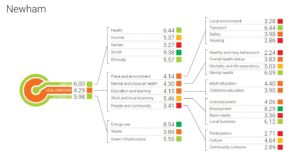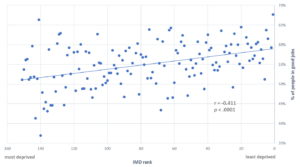Using data to inform wellbeing policy: insights from the Thriving Places Index
Message from the What Works Centre for Wellbeing: The Centre for Thriving Places has produced the Thriving Places Index. It’s an important tool that can help local authorities and communities understand wellbeing in their local context. We continue to work with local authorities and community organisations to support them with evidence-informed responses to maintain wellbeing and reduce loneliness in the current situation.
The Index gives a clear picture of the immediate conditions across the UK prior to the global pandemic. This can give an indication of the assets of each area and of the people living there. This context can help all of us – the public, private and voluntary sectors, and our communities – understand the likely impacts, the strengths on which to build, and how best to help.
The Thriving Places Index is a local (community) wellbeing index – of which personal wellbeing is just one part. When it comes to the three biggest drivers of overall personal wellbeing:
it is already apparent that these have been significantly impacted.
We know that a caring and effective community – our social fabric – supports national, community and organisational resilience. Having someone to rely on in times of trouble, generosity, a sense of belonging and shared purpose increases positive emotions and a positive response to crisis.
Using data to inform wellbeing policy: insights from the Thriving Places Index
Today, the Centre for Thriving Places have launched the fourth annual Thriving Places Index (TPI) – a framework which measures how well 363 Local Authorities in England and Wales are delivering the conditions for wellbeing.
The Thriving Places Index takes an asset-based approach to measuring the drivers of wellbeing and consists of a broad set of indicators from datasets produced by established national data agencies such as the Office for National Statistics and the Index of Multiple Deprivation. These indicators are arranged into headline elements – local conditions, sustainability and equality, domains and sub-domains which reflect this asset-based approach.

The Thriving Places Index shows the conditions for wellbeing in 363 Local Authority areas in England and Wales.
Looking at complex relationships between wellbeing and other local factors
For example, creating a measure that captures how employment is related to wellbeing could be approached quite simplistically. Many datasets measure levels of unemployment or income, which could lead to the conclusion that higher incomes or higher levels of employment equate to better wellbeing. But the relationship between employment and wellbeing is more complex than this.
For this reason, the TPI includes an indicator of good jobs, which considers whether people are earning a living wage, whether they have job security, and whether they are working the number of hours they want to without overworking. By combining several factors the good jobs indicator takes a more holistic view of work and wellbeing. This indicator contributes to a local authority’s sub-domain score for ‘Employment’.
The What Works Centre for Wellbeing has also developed work on this, including a wider ‘job quality’ definition.
Challenging assumptions about places
Sometimes the results of the TPI and this asset-based approach can conflict with the assumptions made about deprived places. At other times it illustrates a more complex picture of affluent areas – showing that the conditions for wellbeing may not be delivered either equitably or sustainably.
Newham, a London borough, is one of the 10 most deprived upper tier local authorities according to the Index of Multiple Deprivation, and has a low score of 4.29/10 on Local Conditions. Yet 66% of people in Newham are estimated to be working in a good job (2nd of 144 local authorities).

Newham’s 2020 Thriving Places Index Scorecard

There is a moderate significant correlation between the Index of Multiple Deprivation and the good jobs indicator (see graph) but not all local authority areas conform to this trend.
What does it mean for policy?
Applying a holistic wellbeing lens by using the the Thriving Places Index means that policy makers can understand how complex factors interrelate and increase the chances of any intervention’s success in a particular area. It also makes it possible to measure the impact of interventions in a robust and evidence-based way – optimising the possibility of creating effective change. Above all, it highlights the need for a nuanced, place-based understanding of wellbeing to be included in policy design.
Our local government and health programme, led by Joanne Smithson, has three focuses:
Placing wellbeing at the heart of local government
Wellbeing data and insight
Wellbeing economies.
If you'd like to find out more about our work, or share your experience, please do get in touch.
